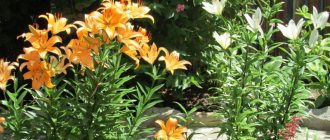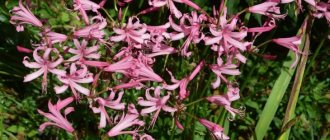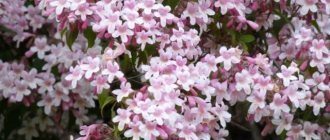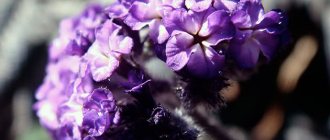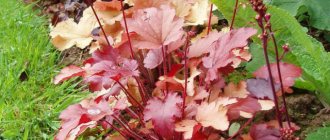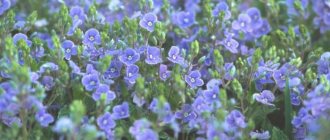Description of the bush
Deutzia is a member of the hydrangea family. This shrub came to us from Central America and East Asia. Despite the impressive number of varieties, gardeners grow only a few of them on their plots. The shrub itself has a unique beauty, and varieties that were specially bred are even more striking in their sophistication and attractiveness.
Elongated, pubescent foliage does not cover the shrub all year round, but only in the warm season. Loose inflorescences consist of white and sometimes pink buds. The shape of these inflorescences resembles clusters. You can admire their beauty for a relatively long time – from spring to August. Thanks to this feature, the plant is considered one of the famous ornamental plants.
Planting and care
Deutzia is not particularly demanding in care and almost any type of soil is suitable for planting, but for abundant flowering it is still worth adhering to certain rules and creating favorable conditions for growth and development.
Deutzia is a light-loving shrub. A place in the garden where there is partial shade, for example under spreading trees, moderately humidified air and diffused sunlight, is perfect for this. The ideal would be fertile with clay areas without groundwater and a neutral reaction. Waterlogged soil is not suitable for planting, so it is recommended to plant it on a hill. Deytsia does not tolerate drafts well, so it is necessary to provide it with only a light breeze. It is best to plant deutia in the spring, before the buds begin to bloom. If the plant is not propagated, but is planted purchased, then it is better to buy seedlings with bare roots in order to ensure their integrity and health. It is necessary to dig a hole 40-50 centimeters deep for the proper development of the root system, and plant the shrubs themselves at a distance of at least one and a half meters from each other.
Immediately before planting, it is necessary to apply fertilizer - 1 bucket of compost, and for better flowering, it is necessary to periodically fertilize with liquid manure diluted in a ratio of 1 to 10. After applying liquid fertilizer, it is recommended to water the Deytsia with clean water and mulch. During the flowering period, complex mineral fertilizers are applied; phosphorus-potassium fertilizers are best suited.
It is necessary to water the bushes rarely, up to 5 times a month even in hot, dry summers, but abundantly - about 40-45 liters of water per 1 square meter! In this way, all the soil around the roots will be saturated with moisture and will nourish them with the necessary nutrients.
Several times a month you need to loosen the soil to a depth of 25-30 centimeters, at the same time removing growing weeds around.
A special feature of the action is the presence of a hollow hole in the middle of the stem, making it very easy to break. This must be taken into account when caring for shrubs and wrapping them for the winter. Most varieties have low cold resistance. Warm-loving varieties require wrapping with burlap or special material; for all others, mulching with straw or pine needles, or, in extreme cases, fallen leaves, will be sufficient. The main thing is not to delay removing the cover in the spring, as this will not allow the bush to develop and grow normally.
It is important to carry out sanitary pruning every year, removing all dried stems, as well as tips that froze or did not ripen last season. Bushes that are too dense need to be thinned out. The recommended pruning time is early April. The correct and timely pruning of the shrub determines how lush its flowering will be next year. The plant tolerates pruning well.
Actions are very rarely exposed to pests and various diseases, but preventive treatment still won’t hurt. For example, 0.15% phthalophos solution. During mass damage by caterpillars (second half of summer), it is recommended to treat the bush with one of the biological products: Bitoxibacillin, Biofungicide, Bisolbifit, Fitoverm and others.
You may also be interested in reading:
Mock orange crown
Buddleya David
Garden hydrangea: description, planting and care
Planting action
When to plant deutsia. It is necessary to start planting the plant after the soil has thawed after the winter, but before the buds open. But, if the seedling has a closed root system, then this procedure can be carried out before June. In order for a seedling to grow well, you need to choose the right place for it. Here are some points to consider:
- Deytsia needs free territory;
- After 12 noon, the sun should not shine directly on the plant;
- Cold wind is also prohibited;
- A good soil for deytsia will be one that has a lot of useful elements and a moist consistency. In addition, it must be well drained and have low acidity.
If there is no suitable soil, then it is recommended to pour a soil mixture of humus, peat compost and sand into the planting hole in a ratio of 2:1:2. And with high acidity, it is necessary to add slaked lime (0.3 kg).
Deutia seedlings. In order for the deutzia shrub to grow and develop well, you should take a responsible approach to choosing a seedling. When purchasing, you should carefully examine it for damage and symptoms of disease, as well as the condition of the kidneys - they must be intact. There are two options for seedlings at the time of purchase - with closed roots when the plant is in a container, and open. The advantage of the latter type is, for example, that you can easily assess the condition of the roots. But, importantly, the price of such a seedling is lower than that in the container.
How to plant deutsia. Since this shrub prefers free space, it is necessary to place it on your site so that there are no buildings or plants within the next 2.5 meters to it. When the action becomes an adult, its size will take up a lot of space. Planting work is carried out in the following stages:
- Clearing the land of weeds. This is necessary to prevent weeds from taking away the nutrients, sunlight and water that the main plant needs.
- Creating a planting hole. Its dimensions should be 30 centimeters in diameter and 40 centimeters in depth or correspond to the size of the container. The hole should not be small, otherwise the root system cannot be freely distributed throughout it, which means that it will not be completely covered with soil.
- Loosening the soil. In order for the seedling to easily take root further, it is recommended to loosen the bottom and walls of the hole a little.
- Preparation of seedlings. Within 20 minutes, their roots should be placed in water.
- If the seedling was purchased in a container, it must be removed and the roots checked. It happens that they become excessively twisted and compacted. To help the plant, it is recommended in such cases to make cuts at several points in the root ball. After this, the roots will be easy to straighten.
- Formation of shoots. All dry foliage and shoots that are damaged in any way must be removed. All other shoots are shortened by a third. With this operation, the risk of fungal diseases is reduced, and the appearance of the plant as a whole becomes better.
- Planting process. The bottom of the hole should be covered with fresh soil, and then the seedling should be placed. To plant the plant at the desired depth, you can use a shovel or other long narrow object. It is installed horizontally above the pit, resting on opposite sides. From the center point of the shovel to the deepest point of the hole, the resulting depth will be shown. The seedling must be planted in such a way that the root collar is at ground level. If you purchase a plant in a container, you should focus on the depth at which it was planted in the container - a maximum of 5 centimeters below the ground line.
- Filling with soil. As the soil pours out, it should be compacted carefully. If there is not enough soil, you need to add more.
- Some, to conserve water and better provide it to the roots, create a hole around the bush.
- Watering. Immediately after planting, the bush should be watered. If the work was carried out in the middle of the season, then the watering procedure is carried out even more carefully. If after this the ground settles and exposes the roots, it is necessary to add more soil.
- In order to weed the ground less often, you should use agrofibre or mulching.
Landing
Planting will be effective only if it was carried out according to all the rules. Here we can highlight the following components:
- place;
- priming;
- landing algorithm.
Choosing a landing site
Before planting and thinking about caring for the action in the open ground, you should find a place for it. This is a light-loving shrub, but it will be negatively affected by direct sunlight, as well as drafts. A southern or western slope is ideal for planting.
Therefore, when choosing a place for the action, it is best to stop at a short distance from the tree, about 2 m. There should be no trees or buildings nearby.
The soil requirements are as follows. The exotic bush will grow best in the ground:
- nutritious;
- moderately moisturized;
- loose;
- drained;
- with a slightly alkaline reaction.
When preparing the soil yourself, you should take 2 parts humus, the same amount of sand and 1 part peat compost. If the soil is highly acidic, 300 g of slaked lime should be added to the ground before planting.
Planting a bush in open ground
Those who plant deutia in open ground for the first time do not know when to do this. So, it is best to plant in the spring. Then there is a lot of time left before frost and the seedling will have time to get stronger. But as for the Moscow region, planting in open ground and caring for the action has its own characteristics. You should choose according to the weather. The time will come when the earth will thaw, but the buds on the trees have not yet blossomed.
Since the Urals have harsh winters, any variety will not be suitable for planting in this region. To grow an exotic bush, residents of this area should select winter-hardy varieties. Hybrids that are characterized by increased winter hardiness are also suitable.
The action will grow and develop better if, after planting, the shoots are cut to 4-5 buds.
We plant, adhering to the following algorithm:
- We prepare a hole, the depth of which should be 50 cm.
- Lay out a layer of drainage.
- Sprinkle a little prepared soil onto the drainage, adding 100 grams of nitrophoska.
- We omit the root. The root collar should remain on the surface.
- We fill it with soil; it must be compacted and the soil mixture must be moistened.
- The area around the seedling should be mulched. The ground is covered with peat to a depth of 4-5 cm.
Action care
How to care for action. To make the minimum list of caring for this shrub even smaller, it is recommended to mulch the area around the trunk. As for watering, one bucket of water should be poured under its root system every week. When dry, hot days come, you can pour out two buckets of water. But after the 15th of August this procedure should be stopped. When the plant is watered, it is necessary to loosen the top layer of soil - approximately 20-25 centimeters from the soil surface. if there are weeds, a procedure is also carried out to remove them.
Fertilizers must be applied every month. For this, liquid manure is used at a rate of 3-4 liters per specimen. Twice a season during flowering, complex mineral fertilizers should be applied. One bush should take 120-150 grams.
Transplantation of action. In order for the plant to have time to take root in a new place before the onset of winter, it must be replanted in the spring. To carry out this procedure, you must first properly prepare the planting hole. Its bottom is covered with a drainage layer, and then approximately 25 grams of complex mineral fertilizer are added. After this, carefully remove the bush from its place. To do this, focusing on the crown, you should draw a perimeter on the ground and dig around it. At the same time, it is important not to destroy the roots with a lump of earth. When the plant can be freely pulled out of the soil, it is taken out and the prepared planting hole is moved. After this, the plant is covered with a soil mixture similar to that which was used during the initial planting, gradually compacting it, and watered generously.
When the action is already in a new place, an operation should be performed so that it can take root with minimal losses. To do this, old branches are removed, the shoots are shortened by a third, and the area around the trunk is mulched. You should know that only young specimens take root quickly. But for adults this is quite painful.
Action trimming. Unlike many plants, deutia should be pruned twice annually. Spring and autumn are suitable for this work. Before the onset of winter, it is necessary to remove those branches that have already become old or simply interfere with the free development of the bush. Those branches on which flowers have bloomed during the current year must be cut back to the place of the first mature bud or removed completely. Also, after the flowering period is over, gardeners form the crown. With the onset of spring, pruning should be done for sanitary purposes. To do this, branches that are frozen are shortened, and those that were damaged during winter are pruned. It happens that an impressive number of shoots have become unsuitable for further development. Therefore, provided that the root system is well developed, the bush is pruned under the stump, after which it is restored and produces new healthy shoots. Pruning for the purpose of rejuvenation is carried out in a similar way.
Pests and diseases of action. This plant encounters such problems quite rarely. But it happens that aphids and leaf rollers attack the bush. To control these pests, it is best to remove diseased leaves. Among the diseases you may encounter are:
- Diseases of fungal origin. One such problem may be rust, which can appear due to high humidity and high temperature. Its signs are rusty round spots. For treatment, diseased foliage should be removed and burned. And treat the shrub with fungicides several times.
- Powdery mildew. For the same reasons, a white coating may appear on the foliage. To combat it, it is recommended to immediately remove the affected parts and then treat with a fungicide.
Good prevention is regular pruning and weed removal.
Common varieties of shrubs
Due to the active development of such art as landscape design, exotic species are becoming more and more common in gardens and urban recreation areas. White and pink Deutzia gracefully complement any landscape composition, therefore they are an integral part of the designer’s work. Winter-hardy varieties of Deytsia are common in our area.
It will be interesting to know - Tulips: where to buy, how to care and much more
Pink
It turned out as a result of crossing two representatives: Deytsia Purple and Graceful.
The bushes grow very slowly and are small in size, reaching a height of no more than one meter. The crown is spreading, so the plant resembles a ball in its configuration, because it can reach the same size in both height and width.
The leaves are dark green, oblong in shape, covered with villi on the front and back sides. They grow up to 15 centimeters in length.
It blooms for a long time - from one to two months. The flowers are pink with elongated oval petals. The shade on the petal varies from deep pink to almost white. Each flower resembles a bell.
Deutzia scabra
This variety got its name literally - for its roughness. The leaves and shoots are covered with numerous villi. Homeland - Japan. It began to land in Russia in the 19th century.
Grows up to 2-2.5 meters.
The leaves have an elongated oval shape, up to 7 centimeters long, and a light green hue. By autumn, the coloring changes to yellow or brownish.
Deutia Shershavaya blooms in mid-summer and does not last as long as other species - only 2-3 weeks. The calyxes are white or pink, the petals are elongated in configuration, with sharp edges. The buds are large, terry, and grow up to 12-15 centimeters in length.
This type can be planted either as a single specimen or as a hedge. Rough does not tolerate severe frosts, so it is not advisable to grow it in the northern regions.
Varieties of Deytsiya Shershavoy
Rosea Plena
White pom-poms are what the heads of this species of action look like - the undoubted beauty of this representative. A fascinating decoration of the bush are numerous small earrings collected in dense snow-white inflorescences. The flowers are full and resemble small white pompoms, slightly pink on the outside. It blooms very profusely in June and July, the branches bend under the weight of the cups. Large and compact - 2.5-3 m tall. The leaves are dark green, up to 12 cm in size, all covered with coarse hairs. The bark on old branches peels off, which adds to the charm of the plant in winter. This undemanding and efficient shrub is very practical for small gardens. It is worth getting interested in it because of its beautiful flowering, which undoubtedly determines the beauty of the plant.
Pride of Rochester
Grows to a height of 2.5 m, rigid branches, erect, with slightly peeling bark. Petals are wide 50-100 mm. long, rough, dark green, slightly convex on long shoots. Flowers up to 30 mm. in diameter, full, white. The outside petals are dark pink, striped, narrow. Collected in dense but narrow panicles up to 150 mm long. Blooms profusely at the turn of June and July. The fruits are small, dry, without a decorative effect, and remain on the bushes throughout the winter. Pride of Rochester was obtained from Ellwanger and Barry nurseries, USA, in 1890. Quite frost-resistant. Undemanding to soil, grows well on almost any substrate, except dry, sandy and very wet. It grows best on compact, humus, moderately moist soils with a slightly acidic or slightly alkaline reaction. Grows best in sunny to semi-shady locations. Drought resistant. It should be planted in quiet places protected from winds. Recommended for garden plots, holiday villages, greenery and parks. Planted individually and in small groups. An excellent variety with large and full inflorescences, worthy of wide distribution.
Codsell Pink
Deutzia Codsall Pink has a thick and dense vertical crown. 2.5-3 m high and up to 2 m wide. Shoots with red or gray-brown bark, which can later peel off effectively. The shoots themselves are straight, although the ends hang down. And under the weight of abundant flowers, the branches can bend even more, giving the Codsall Pink deutia a weeping appearance. This action blooms in June-July, later than other species. Its spectacular appearance when the buds open is provided by numerous star-shaped delicate white or pinkish to light crimson flowers. Flowers up to 15 mm in diameter, collected in panicles 60-15 mm. long, covered with small hairs. The leaves are oblong, with a pointed tip, green; in autumn the foliage turns yellow-brown.
Candidissima
Shrub with erect, rigid branches. Grows up to 2-3 m in height. The leaves are dark green, narrowly ovate, with a sharp tip, with a serrated edge, roughly pubescent on both sides. The flowers are full, with snow-white petals, pink on the outside, collected in thin inflorescences. pleases with its beauty at the end of June and July. Requires a sunny or semi-shaded location, but moist. Deytsia prefers well-drained, humus soil. Incomplete frost resistance; in severe winters it can freeze to the snow line, but recovers well after pruning. After flowering, you can apply pruning, which consists of shortening or trimming parts of the oldest branches. For planting in home parks and gardens, it is recommended for urban sowings in groups and rows.
Hybrid
There are several hybrid species of Deytsia, because they are obtained by crossing other popular ornamental varieties. Hybrids include: Amur Deytsia, Lemoine, Mont Rose, Strawberry Fields, Pink Pom-pom.
Amur Deytsia is distinguished by the shape of its flowers - they are very small compared to other species. Deutzia hybrid is very picky to care for and requires special lighting conditions and constant humidity.
Lemoine is a hybrid of Amur and Graceful Deytsia. Reaches a height of a maximum of 1 meter, the inflorescences resemble white pyramids and are 15 centimeters long. The leaves have a grey-green hue, giving Lemoine its distinctive appearance.
Mont Rose is distinguished by the purple hue of its cups; during the flowering period, they become bright pink, and the petals curl outward. Quite large, can grow up to 2.5 meters in height. It blooms for a whole month. It is unpretentious in care and choosing a place for planting; it grows on almost any type of substrate.
Strawberry Fields is distinguished by its large, beautiful pinkish flowers. It grows up to one and a half meters in height. It blooms for about a month. Does not tolerate cold wind well, so choose a place protected from drafts.
Deyzia Strawberry Fields
One of the most valuable (though not the most recent) recommended for planting as an ornamental shrub in home gardens is an intermediate variegated variety developed in the 1980s, elegantly named 'Strawberry Fields'. It attracts attention with dark pink flowers in buds - the darkest deutia ever known. It grows well, reaching 2-3 m in height after several years of cultivation. Initially, it creates straight, rigid shoots, which bend outward with age (under the weight of the blossoming buds). The leaves are light green, dull and rough to the touch, quite wide, pointed, jagged along the edge, 80-100 mm. length. Solid flowers when opened are about 30-35 mm. in diameter and configuration they resemble stars. Their petals are bright pink with a distinctly lighter, almost white edge. There are yellow stamens inside the calyx. The flowers are collected in large paniculate inflorescences. The buds are dark pink before development - they look like strawberries, hence the name of the variety. Blooms profusely throughout June. Since buds form on two-year-old and older shoots, the bushes are not pruned. If necessary, only old, weakened or diseased stems are removed.
Strawberry Fields photo
The soil has no special soil requirements; it grows well in most average garden soils, with the exception of dry, sandy or very wet substrates. Prefers sunny positions and quiet places protected from strong winds. The type is characterized by good frost resistance, although in severe winters (especially in the east of the country) it may partially freeze. However, even so it recovers well (after heavy pruning), although it will not bloom this year.
Deutzia Mont Rose
A representative of the family with raised, slightly overhanging shoots. Grows up to 1.5 m in height and similar width. Wide lanceolate, dark green, rough leaves. Pinkish, relatively large, star-shaped, five-petaled flowers, collected in loose inflorescences. Pleases with its beauty in late spring and early summer. Fruits without decorative value. Designed for sunny locations, moderately moist, well-drained soil, not entirely tolerant of low temperatures, may freeze in severe winters. Frozen and dry shoots should be pruned in the spring. For planting alone and in small groups: in public gardens, in parks and squares, in personal plots. Can be used on unformed hedges.
Pink Pom Pom
Representative with full flowers, white inside, pink outside. One of the most beautiful representatives of the genus. It blooms very profusely in June and July. Catkins are collected in paniculate, effective inflorescences up to 100 mm long. The plant is then covered with specific pink pompoms. Grows up to 2.5 m, with straightened branches and dense dense branches. The leaves are dark green, rough, covered with hairs, 60-80 mm long.
The abundance of flowering means that the branches bend under the weight of the flowers.
Grows about 25 cm per year. At the turn of June and July, this beautiful bush is completely showered with large (25-30 mm) white balls, pinkish on the outside, collected in paniculate inflorescences. The whole thing, covered with flowers, evokes genuine admiration, it is difficult to pass by indifferently.
Graceful Deutzia (DEUTZIA GRACILIS)
Despite its name, Deytsia Graceful or Slender is distinguished by increased resistance to adverse weather conditions, because its homeland is the highlands of Japan and China. It is there that Graceful Deytsia is able to withstand periods of long droughts and cold snaps.
The shape is round, which makes it easy to give the necessary contour when decorating garden flower beds. Height is 1-1.5 meters, the diameter of the crown grows to 1 meter.
The shoots are curved and thin.
Decia the most graceful photo
The leaves are oblong, about 50 mm. in length, have a pointed shape, are covered with small fibers on the front side, and completely smooth on the back side. Depending on the time of year, they change their color from light green to yellow.
It begins to bloom at the end of May and continues for 1-1.5 months. It blooms with snow-white cups, 20 mm in diameter, and the inflorescences, which resemble a bunch in their configuration, reach 100-120 mm. One such bunch can fit 30-40 cups!
The fruits ripen by mid-autumn. Graceful Deytsia is frost-resistant.
Deytsia Nikko
An unusual bouquet when Nikko begins to bloom in May. During the month, each branch is abundantly strewn with white flowers, collected in clusters. Compact variety with beautiful white flowers. Grows up to 70 cm in height and 100 cm in width. Due to its small size, it works well in small flower beds as a ground cover. Suitable for growing in pots, from which it cascades and hangs picturesquely. The star-shaped flowers, collected in clusters, are extremely charming. In May, every branch is covered with white flowers. Delights with beautiful flowering throughout the month. A bush with a compact, dense and rounded appearance. The green, lanceolate leaves turn red-violet in autumn. Nikko is considered one of the best Deutia varieties due to its low, desirable growth. This is the elite among plants, suitable for any garden.
Deutzia gracilis Nikko was awarded the Gold Medal in 1989 by the Pennsylvania Horticultural Society
Magnificent deutzia (Deutzia magnifica)
This species is a hybrid, occurring after the combination of the Shershavoy and Vilmorin varieties.
It grows to a height of 2-2.5 meters, the shoots are shaped like an arc.
The leaves are elongated with smooth ends.
Blooms profusely for about three weeks. The branches bend under the weight and the bush begins to resemble a cloud. The flowers are white and velvety to the touch. They are collected in brushes 10-15 cm long.
Deytsia Magnificent is very resistant to our winters, but only adult representatives of the genus, young shoots should be wrapped.
Action after flowering
No matter how beautiful the flowering is, it ends sooner or later. And so that you can admire it next year, you need to properly prepare the bush for winter. The buds bloom on the shoots that grew last year. Since deutia is not a frost-resistant plant, the shrub should be protected during this period.
Each location has its own rules for preparing for winter. For example, if this plant is located in an area where winters are not very frosty and there is a lot of snow, then you just need to tilt the bush to the soil and fix it. In areas of central Moscow, such preparation includes more procedures. If there is little snow on your property during winter, but frosts can be severe, you need to use a cover for bushes. To do this, the plant is placed on the ground, a frame is placed on top of it, and dry foliage is placed on top. Instead of foliage, you can use spruce branches. When this work is completed, it is necessary to cover the frame with lutrasil and plastic film. It is needed to protect against moisture. This method of preparing a plant for wintering is suitable for those whose branches can still be easily bent to the ground.
Shrubs that have already reached maturity need to be provided with a different type of care. To do this, the plant is tied using twine or barrels, and then wrapped on all sides, including the top, with material that allows air to pass through. Such material can be burlap, spunbond or lutrasteel. This solution will keep the plant warm, but the buds will not dry out.
Photo and description of the action
Deciduous, less often evergreen shrub from 1 to 3 meters in height with hard, branched shoots. The leaves are green, ovate, and often covered with fine hairs.
Conditions for planting rose seedlings in open ground with photos
Deutzia is one of the garden crops that are invisible most of the year and only in late spring - early summer during flowering can you see its beauty. The shrub is covered with hundreds of white, reddish or pink flowers, which turn it into a magnificent flower fountain.
Numerous bell-shaped or star-shaped flowers, which form on the tops of last year's shoots, are collected in loose panicles, the length of which depends on the variety.
After flowering, the shrub is usually used as a green background for flower arrangements. The lifespan of the culture is approximately 25 years.
Types and varieties of action
Deytsia rough
The 2.5-meter shrub is decorated with green foliage on a brown background of bark. The 3-8 centimeter leaves are rough to the touch. The flowering period begins later than other varieties. At this time, the action becomes even more attractive thanks to its pinkish or white buds. The color is so unusual that each species has its own characteristics.
Deytsia Amur
This 2-meter plant has a peculiarity - its bark changes color with age from brown to gray. For three weeks in June, you can observe odorless white flowers, which are collected in clusters in inflorescences resembling corymbs. In addition to beautiful flowers, the bush is decorated with unusual 6-centimeter leaves, pubescent on all sides. Starting in spring, the foliage remains ash-green or bright green, and with the onset of autumn it changes to yellow with a brown tint.
Deytsia rough varieties photo
There are two varieties of Deytsia rough. They have the same care requirements, but bloom and look differently.
Deytsia rough snow-white
This plant blooms with large inflorescences, which are located on the side shoots. One inflorescence can have up to 11 branches with 14 flowers on each. Each flower is about 3 cm in size. They are voluminous, double, and pale white. When the whole bush blooms, it seems that Deutzia has turned into a cylinder.
Under the weight of its color, the bush becomes flexible, its branches bend beautifully. The shrub looks interesting if planted separately. At the same time, you can make a composition of several plants, but for a high-quality background you need a lawn with lush, green grass.
Snow-white Deytsia blooms at the end of May and until the very end of June. This is enough for other shrubs to bloom and your garden not to be empty.
Deytsia rough terry
This type of shrub has similar characteristics, but is distinguished by dense and persistent shoots. It blooms with slightly pink flowers that abundantly cover the shoots. During the flowering period, the bush remains straight, which distinguishes it from the snow-white form. The flowering period lasts just over three weeks. Deutzia terry also blooms in late spring and until mid-summer.
In landscape design, you can combine these plants, and they will create an interesting composition. If you properly care for the plant, it will delight you with abundant flowers every year.
How to trim action?
The first cut is made in the spring immediately after planting the bush, shortening its shoots by 1/3 of the length. If you plant in the fall, wait until spring. Thanks to the first cut, the bush will be well accepted in its new position and acquire a compact shape.
Mature deutsia are pruned after flowering, which usually occurs in June-July. Lush shoots are shortened by half.
A stronger rejuvenation cut is recommended every few years. We thin out the center of the bush, providing optimal access to light.
Which shoots to remove:
- remove old shoots, because the plant blooms most profusely on young branches;
- remove dead, broken and diseased branches;
- We shorten faded branches.
Below is a photo of how to make a cut correctly
Features of planting in open ground
Deutzia can grow on any soil. However, especially acidic soils must first be “quenched” with lime or dolomite flour. The main requirement for planting is soil fertility and good drainage. If groundwater is a problem on the site, care must be taken to ensure good drainage.
Important! Deytsia is not afraid of exhaust gases. For this reason, it can become an excellent hedge between your site and the highway.
Selection and preparation of a site
It should be noted that for all types of actions, it is advisable to choose a planting location near tall plants, so that during the growing season light partial shade is created in the afternoon. If this is not possible, it is better to plant the shrub in an open place. When planting a shrub, it is necessary to exclude the possibility of drafts moving around it.
Landing dates and rules
Deutzia is always planted in early spring, immediately after the snow melts before the buds open. This shrub is not planted in the fall, since it will not be able to fully take root before the onset of frost, and in winter a weak seedling will be doomed to death.
Important! Seedlings with a closed root system can significantly extend the planting period until July.
For planting, you need to prepare a soil mixture of peat (1 part), sand (1 part) and organic matter - humus, compost, etc. (2 parts). It’s good to add about 100 g of nitrophoska there. If you plan to plant shrubs in groups, you need to take into account that the distance between plants should be at least 2.5 m, since an adult bush occupies a fairly large area.
Video: Spring planting action
For planting, it is necessary to prepare a hole 50 cm deep (if there is a danger of water stagnation, then add 20 cm for drainage) and 40–50 cm wide. Place drainage at the bottom: broken brick, expanded clay, shell or washed sand, etc., add part (1/3) of the prepared soil mixture, install the seedling so that at the end of planting the root collar is buried no more than 1–2 cm, or is flush with the soil.
Lightly compact the soil, place the seedling and pour out the remaining mixture, compact and water. If the soil shrinks significantly, add it to the required level. The planted plant is shortened by 3–5 buds. The plant takes root quite quickly and develops well.
Types of perennial shrubs
Oriental beauty, like other ornamental garden plants, has many varieties and species, let’s consider the most popular and widespread in our territory:
- Magnificent (Deutzia Magnifica) is a wide-crowned shrub, 150 cm high. The flowers are umbrella-shaped, large (3 cm in diameter), bloom from the second half of June to the first ten days of July. In horticulture, varieties of this subspecies have been bred, which differ in the specificity of the inflorescences: Formoza - they resemble terry cloth to the touch, Superba - they have the shape of a bell, Erecta - dense flowers that resemble full flowers in appearance.
Deutzia Lemoinei
- Lemoine (Deutzia Lemoinei) - distinguished by a pyramidal inflorescence, each flower is located directly next to each other (2 cm in diameter), the deutzia blooms in May (in normal climatic conditions). If there is high humidity (dampness) in the air, flowering may begin in early summer. Thanks to botanical experiments, the following varieties were developed: Boule de Neige - paniculate white inflorescences, Strawberry Fields - two-color, raspberry-pink, Mount Rose - large flowers, open quite widely during the flowering period, Pink Pom Pom - buds have a bright pink color, bloom in a hemisphere.
- Deutzia Scabra is a shrub with a characteristic rough leaf surface. The older the bush, the more branched the crown becomes. The flowers are small and can be in pink or white. The petals are long, pointed, and the inflorescences are paniculate. The following varieties are most often found in garden plots: Plena, Roseo-plena.
Deutzia Scabra
Application of action in landscape design
Resistance to urban conditions makes deutsia a suitable option for the formation of living borders, design of entrance areas and park zoning. But even alone, as a separate element of a garden design, the plant looks elegant and attracts attention due to the exceptional beauty of its flowers.
Find out also about the weigel shrub in landscape design.
If you have a massive tree group on your site with a large amount of dense green mass, then planting deutzia nearby can visually lighten the composition and add sophistication to it. The undoubted advantages of the plant include its peace-loving nature, the ability to combine with any “neighbors” and feel comfortable next to larger plants, for example, near conifers.
Methods of propagation
The shrub is propagated using traditional methods, the most common of which is cuttings. Good planting material is obtained from developed, healthy, half-lignified shoots. The procedure is performed in June:
- Prepare cuttings 12-14 cm long. The cut should be beveled.
- The sheets are shortened by half (cut off with scissors).
- The cuttings are planted under a film in highly nutritious soil.
- Until rooting, water at least 2-4 times a day, then the frequency of watering can be reduced.
In the spring, young seedlings are sent to a permanent place - look at the photo for the key features of growing deutia:
It is also possible to grow deutia using seeds. They are sown superficially, sprinkled with a thin layer of sand, and covered with glass. Water 2-3 times a day using a fine spray bottle. Early shoots appear after 1.5 months. When leaves appear on them, the plants dive into suitable open soil.
Dividing bushes is the most basic method of vegetative propagation. An adult specimen is dug up and the root system is carefully divided into several segments with pruning shears. The action is immediately planted and cared for in the open ground - according to the general rules (they will be discussed later).


